全文HTML
--> --> -->针对上述问题, 本文提出采用偏振成像激光雷达与短波红外变焦光学系统共孔径复合的方式, 构建双模目标探测成像系统, 这样既减小两套系统的体积、解决两套系统共轴的问题, 又可以解决偏振调制成像激光雷达视场角小、成像质量受到入射角度及云雾等大气条件影响以及短波红外成像目标能量较低的限制. 依照上述思路, 开展偏振成像激光雷达与短波红外复合光学系统设计研究, 采用光学设计软件完成系统光学设计, 并对完成系统像质分析; 采用光学仿真软件对光学系统成像过程、偏振成像激光雷达偏振调制成像过程仿真. 结果表明所设计光学系统成像质量良好、设计正确可行.
 图 1 偏振成像激光雷达与短波红外复合光学系统成像原理图
图 1 偏振成像激光雷达与短波红外复合光学系统成像原理图Figure1. Schematic diagram of the polarization imaging lidar and short-wave infrared composite optical system.
偏振成像激光测距为本系统的核心功能, 其调制过程中主要使用的器件为普克尔盒, 而现有普克尔盒有效利用入射光线角度最大为1°, 这使得偏振成像激光雷达视场角受限[11-13]. 短波红外变焦成像系统通过移动变焦实现长短焦两种模式切换, 其中短焦模式具备较大视场, 用于任务目标探测; 变焦到长焦模式后具备较高分辨率, 在短焦模式发现目标后用于目标识别; 偏振成像激光雷达视场范围与短波红外系统长焦模式保持一致, 在目标识别的同时完成目标测量, 这样系统就完成目标探测、目标识别和目标测量的过程. 以距系统15 km地面物体为目标, 结合系统功能计算指标参数见表1[14,15].
| 参数 | 短波红外变焦成像 | 偏振成像激光雷达 |
| 工作波段 | 0.9—1.7 μm | 0.532 μm |
| 探测器像元尺寸 | 15 μm | 3.45 μm |
| 探测器像元数 | 640 × 512 | 2448 × 2048 |
| 焦距 | 300(900) mm | 725 mm |
| 视场角 | 2° × 1.5° (0.67° × 0.5°) | 0.67° × 0.56° |
| 入瞳直径 | 150 mm | 150 mm |
| F数 | 2(6) | 4.8 |
| MTFdesign | ≥ 0.408 | ≥ 0.408 |
表1复合系统参数指标
Table1.Parameter of the composite system.
2
3.1.望远镜组设计结果
采用离孔径的方式实现离轴, 便于设计完成后的加工制造以及检测装调; 孔径光阑设置在主镜上, 便于整体光学设计; 在次镜和三镜之间的中间像面处设置一面平面反射镜来折叠光路, 以减小系统的体积; 同时平面反射镜设置成为视场光阑, 这样可以起到有效减少系统杂散光的效果. 其光路图如图2所示, 主镜3、次镜4、三镜7面型均采用二次曲面, 系统入瞳直径为150 mm, 出曈直径为50 mm, 缩束比为3倍.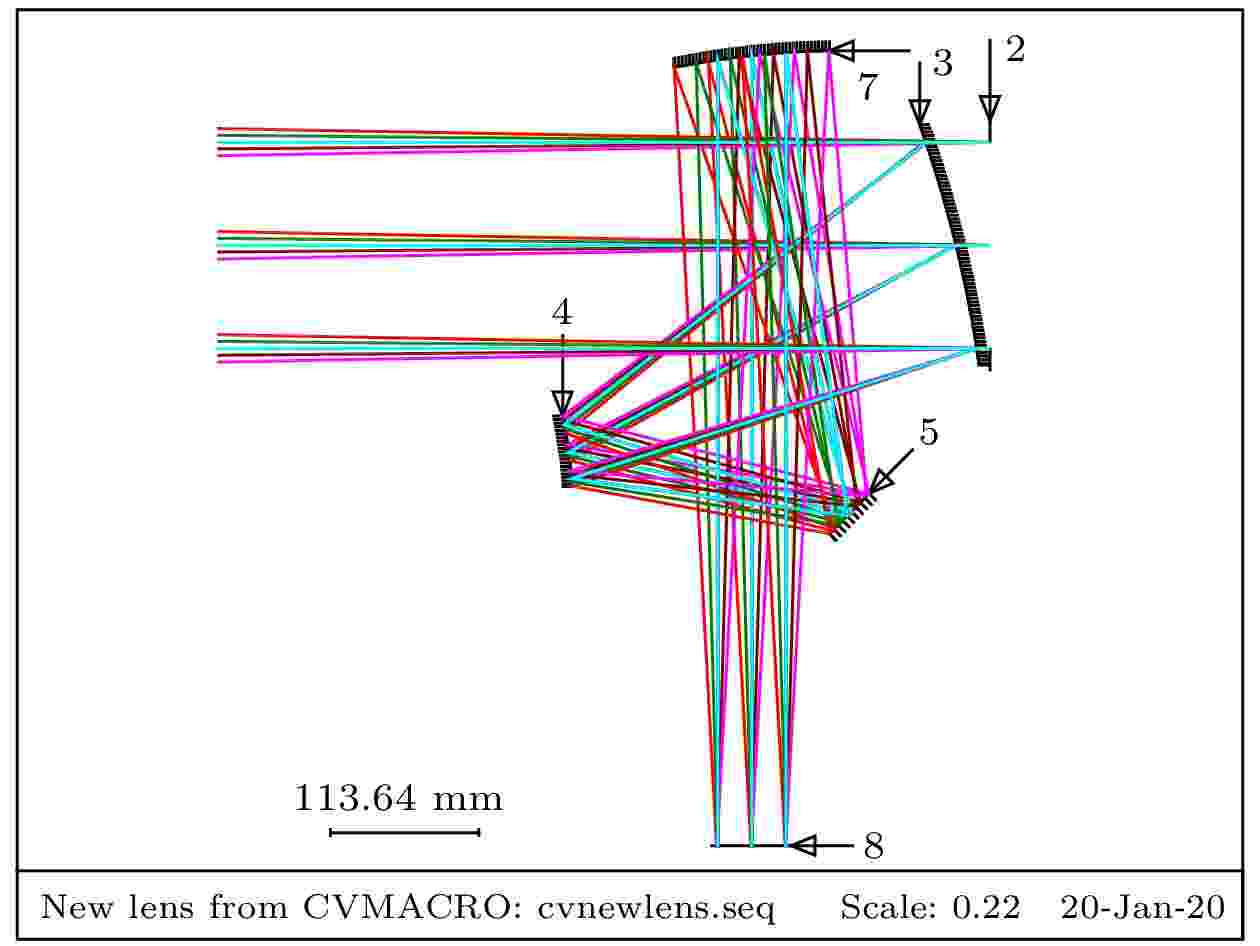 图 2 接收光学系统光路图
图 2 接收光学系统光路图Figure2. Optical path figure of the receiving optical system.
对其进行像质评价, 结果如图3所示, 工作波段的调制传递函数(MTF)已经接近衍射极限, 各个视场所成像斑均在艾里斑内部, 光斑RMS (均方根)直径均小于5 μm. 分析结果表明望远镜组成像质量良好, 光学设计满足系统要求.
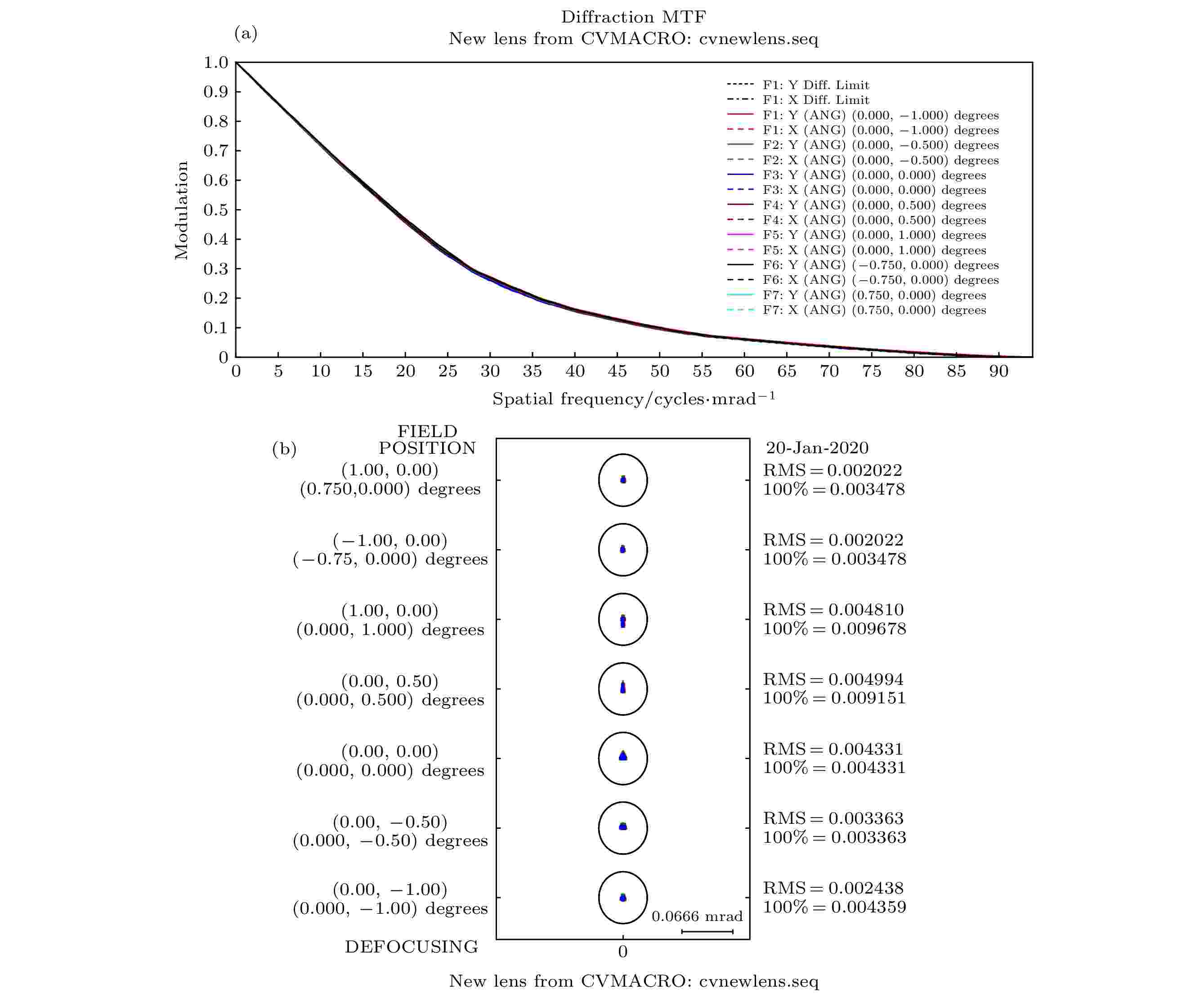 图 3 接收光学系统像质分析图 (a) MTF图; (b)点列图
图 3 接收光学系统像质分析图 (a) MTF图; (b)点列图Figure3. Image quality analysis diagram of the receiving optical system: (a) MTF diagram; (b) point column diagram.
2
3.2.短波红外成像镜组设计结果
短波红外成像镜组与望远镜组合置后光路图如图4所示, 短波红外成像镜组由前固定组(10—13面)、变倍补偿组(14—17面)、后固定组(18—21面)三部分6片镜片组成. 使用直线电机带动变焦补偿组前后移动来实现系统光学变焦, 系统总长固定为551.8454 mm, 镜片材料分别选择ZNSE和IRG26两种材料, 其中IRG26为红外硫系玻璃.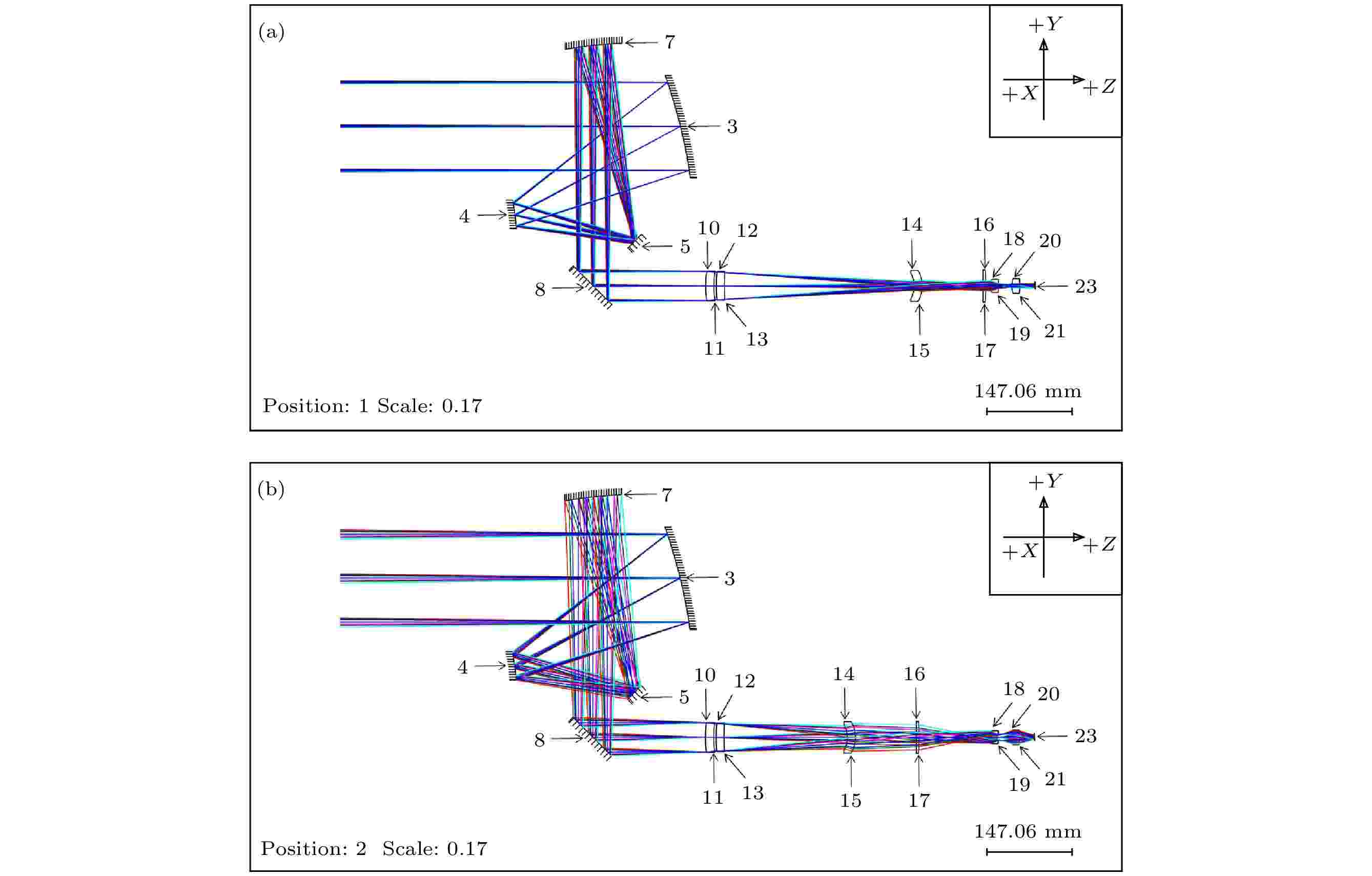 图 4 短波红外成像镜组光路图 (a)长焦模式, 焦距为900 mm; (b)短焦模式, 焦距为300 mm
图 4 短波红外成像镜组光路图 (a)长焦模式, 焦距为900 mm; (b)短焦模式, 焦距为300 mmFigure4. Optical path figure of the short wave infrared imaging lens: (a) Long-focus mode (the focal length is 900 mm); (b) short-focus mode (the focal length is 300 mm).
对其进行像质评价, 结果如图5所示, 两种焦距光学系统MTF曲线均接近衍射极限, 系统视场光斑RMS直径大小均在3.2 μm及9.3 μm以下, 均小于探测器15 μm像元大小. 分析系统斯特列尔比可知, 长焦模式系统斯特列尔比最小值为0.985, 最大值为0.997, 都接近于1; 短焦模式系统斯特列尔比最小值为0.850, 最大值为0.990, 只有子午方向边缘光线斯特列尔比略小, 其他也接近于1. 分析结果表明短波红外成像镜组成像质量良好, 光学设计满足系统要求[17].
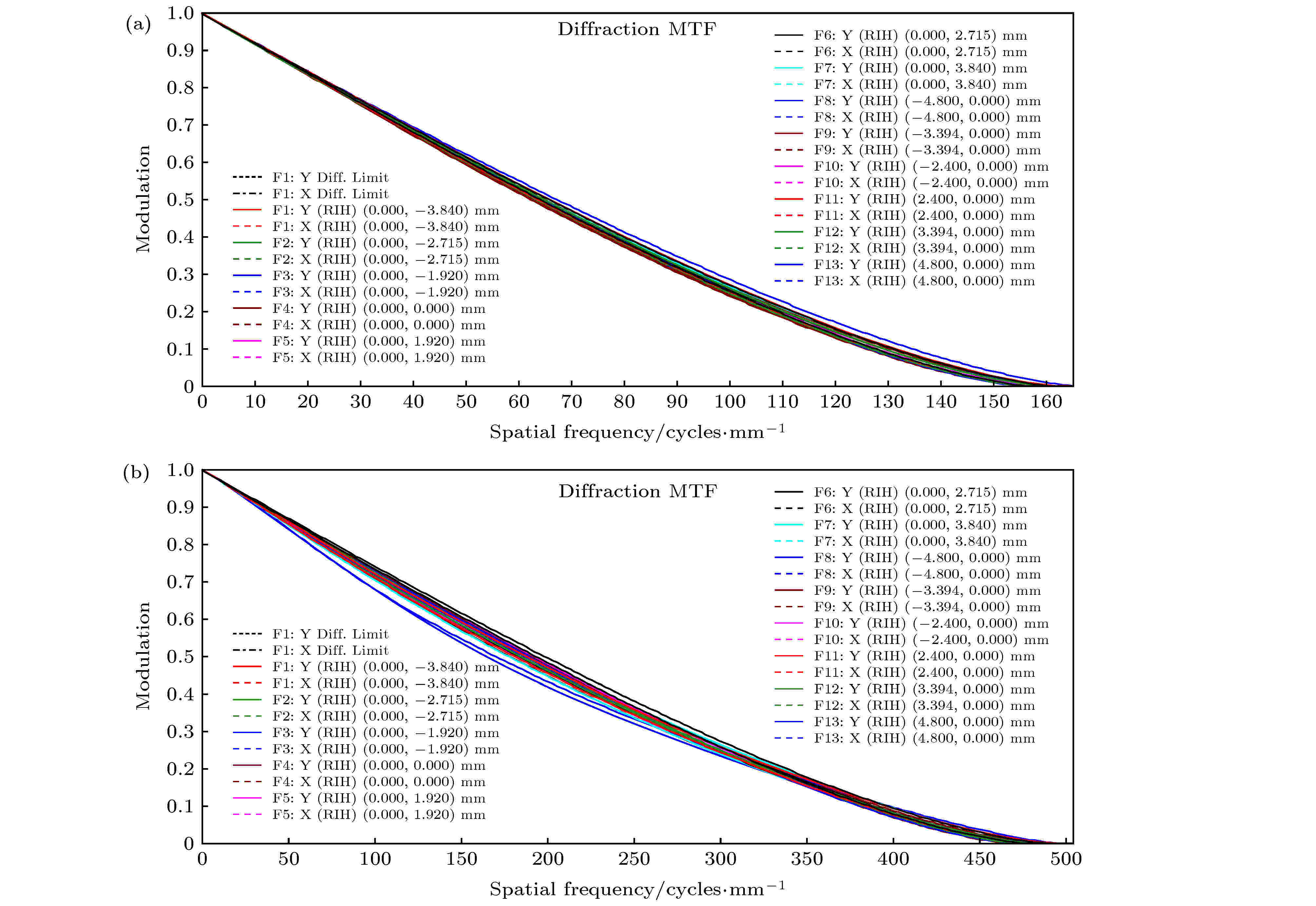
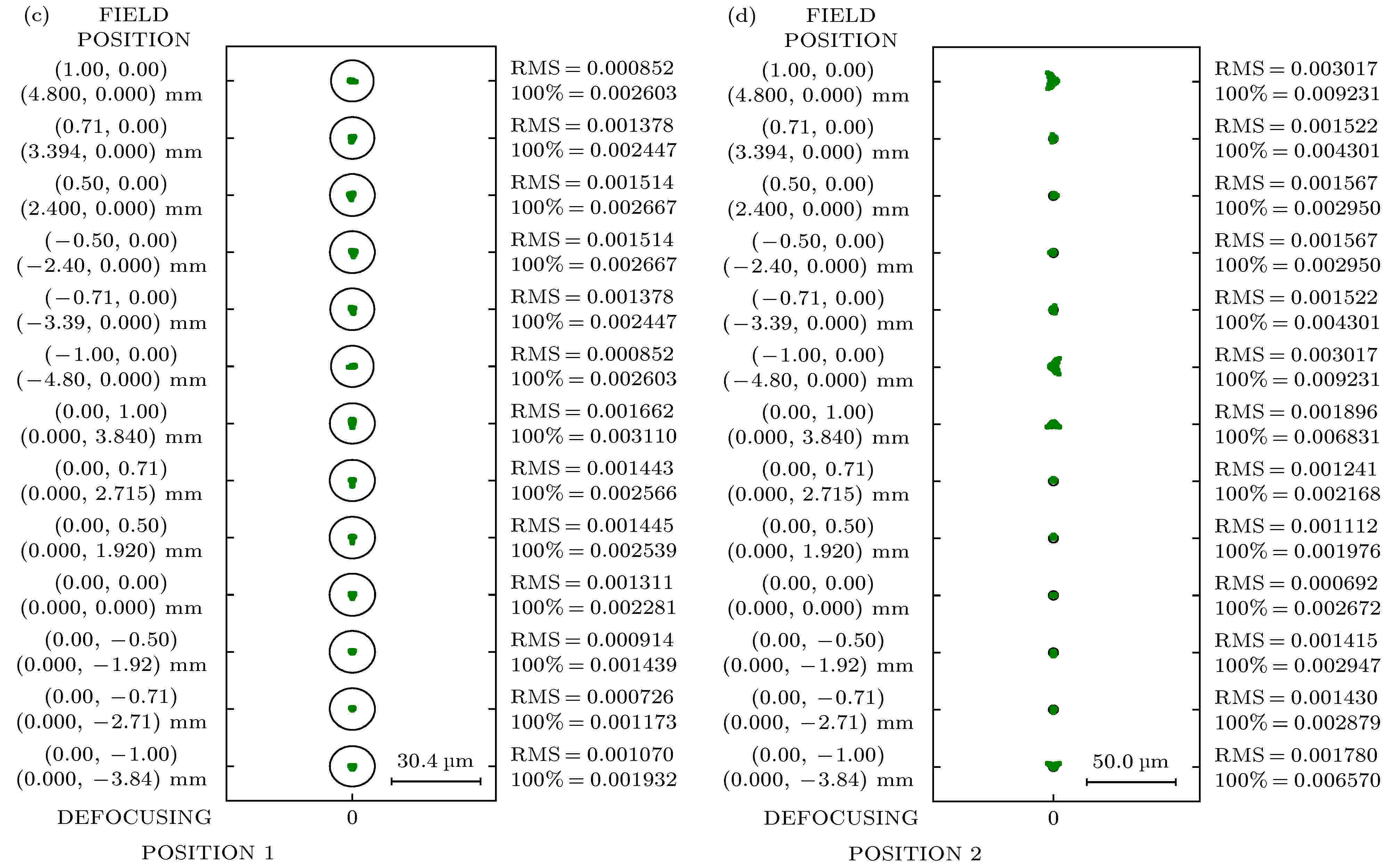 图 5 短波红外成像镜组像质分析图 (a)长焦模式MTF图; (b)短焦模式MTF图; (c)长焦模式点列图; (d)短焦模式点列图
图 5 短波红外成像镜组像质分析图 (a)长焦模式MTF图; (b)短焦模式MTF图; (c)长焦模式点列图; (d)短焦模式点列图Figure5. Image quality analysis diagram of the short wave infrared imaging lens: (a) MTF diagram of the long-focus mode; (b) MTF diagram of the short-focus mode; (c) point column diagram of the long-focus mode; (d) point column diagram of the short-focus mode
2
3.3.偏振调制镜组设计结果
偏振调制镜组由偏振片(P)、普克尔斯盒(PC)、四分之一波片(QWP)、成像镜组(L)、MCCD相机组成, MCCD可分别在0°, 45°, 90°, 135°四个偏振方向成像, 通过这四个偏振方向光强相互计算得出PC所引入相位延迟, 进而间接算出光束飞行时间, 实现并行激光测距[10]. P, PC, QWP使用BK7平板玻璃表示, L使用成都光明生产的HLAK1和HZF6两种玻璃材料, 光阑设置在PC第1面上, 与望远镜组合置后光路图如图6所示. 同样使用前述的MTF、点列图等方法对其像质分析可知, 各视场MTF均接近衍射极限, 光斑均在艾里斑内、RMS半径大小均在0.002 mm以下, 均小于探测器3.45 μm像元大小. 同样光学设计满足系统要求.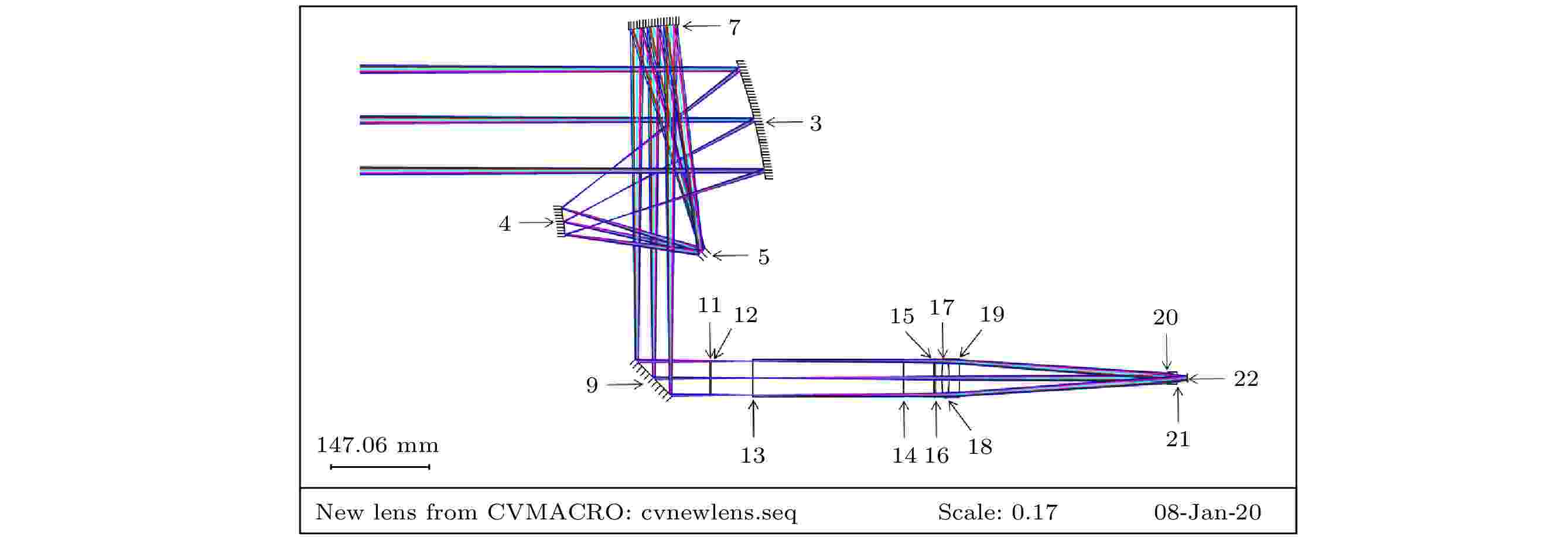 图 6 偏振调制镜组光路图
图 6 偏振调制镜组光路图Figure6. Optical path figure of the polarization modulating lens.
4.1.公差分析
对3.2节和3.3节中所设计光学系统(已经与3.1节所设计望远镜组合置成一套系统, 共孔径部分公差分配值保持一致)进行公差分析, 将望远镜的主镜表面倾斜α, 并与成像像面一起作为补偿器, 主镜补偿范围为 ± 0.002 rad, 成像像面补偿范围为 ± 0.5 mm, 使用复色MTF公差标准反向灵敏度计算, 分别在空间频率33和50 lp/mm处所有视场及所有变焦范围内进行分析. 经过反复调整分析, 系统参数公差值部分如表2所列, 由公差结果可得, 大部分公差在工业级范围内, 只有少数公差在精确级公差范围内, 说明系统整体属于较易加工装调的范围[18,19].| 公差项 | 短波红外成 像镜组 | 偏振调 制镜组 |
| 曲率半径公差最小值/mm | 0.01 | 0.1 |
| 厚度公差最小值/mm | 0.01 | 0.5 |
| 表面不规则度公差最 小值/ring | 0.5 | 0.5 |
| 空气间隔公差最小值/mm | 0.04 | 0.08 |
| 装调偏心公差最小值/mm | 0.01 | 0.02 |
| 装调倾斜公差最小值/mrad | 0.15 | 0.15 |
| 折射率公差最小值 | 0.002 | 0.001 |
表2光学系统公差值
Table2.Tolerance value of the optical system.
2
4.2.成像仿真分析
根据上述光学设计结果, 使用光学仿真软件建立系统仿真模型, 在距模型进光口15 km的系统视场范围内设置待测光源(图7), 以仿真不同形状目标物体在系统中成像过程, 在视场范围外设置有杂散光光源, 以仿真视场范围外杂散光[20]. 图8给出了系统的光学仿真模型图, 其中偏振器件P, PC, QWP按调制原理分别设置为线性起偏器、旋转45°线性延迟片、旋转0°线性延迟片.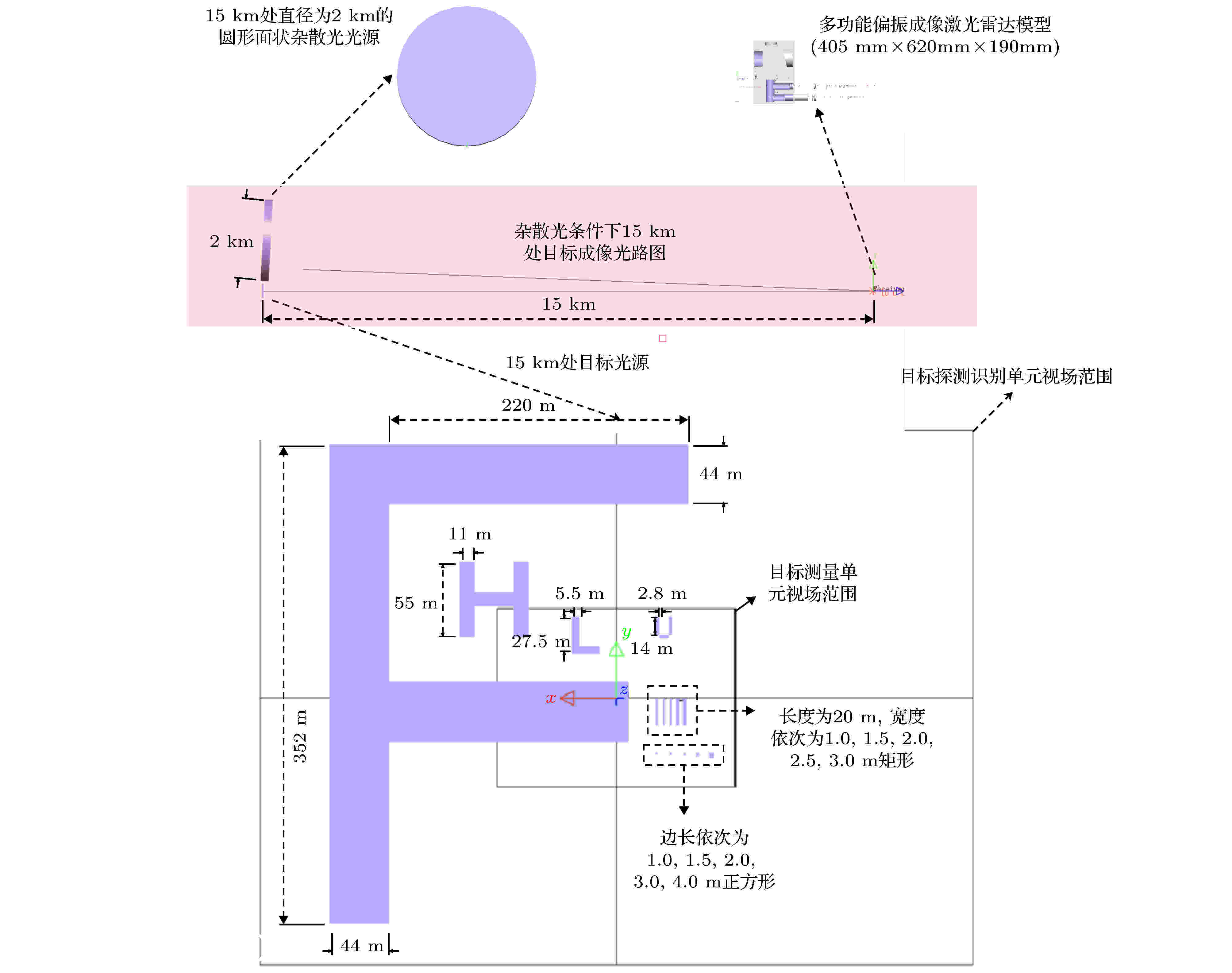 图 7 杂散光条件下15 km处目标成像仿真光路及目标光源图
图 7 杂散光条件下15 km处目标成像仿真光路及目标光源图Figure7. Target imaging simulation optical path and target light source diagram at 15 km under stray light condition.
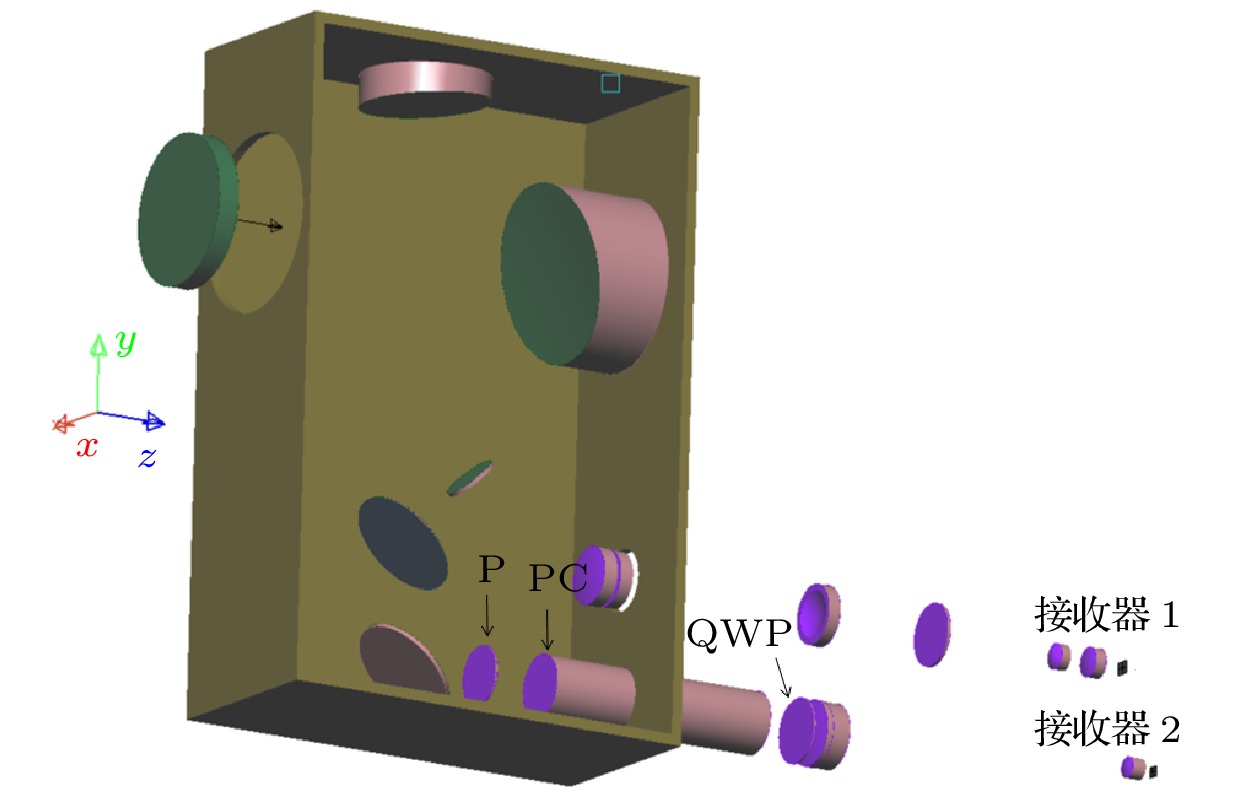 图 8 系统的光学仿真模型图
图 8 系统的光学仿真模型图Figure8. Lighttools simulation model diagram of the system.
通过对107条光线追迹, 相对光线功率阈值设置为10–12, 在杂散光条件下, 正向模拟完成系统成像仿真过程, 成像结果如图9所示. 由分析可知, 视场范围内, 杂散光较少, 可以忽略; 短波红外短焦模式时, 目标探测识别单元边缘视场存在少量畸变, 畸变量小于5%, 目标边缘成像清晰; 能分辨直径1 m的独立正方形目标, 当形状相似的目标之间距离小于3.25 m时, 系统无法完全区分. 短波红外长焦模式时, 视场范围内成像畸变较小, 目标边缘成像清晰, 能分辨直径1 m的独立正方形目标, 当形状相似的目标之间距离为2.25 m时, 系统依然可以进行区分, 而偏振成像激光雷达与短波红外长焦模式成像视场范围、成像质量与目标探测识别单元长焦成像基本一致. 整体来说, 系统成像质量较好.
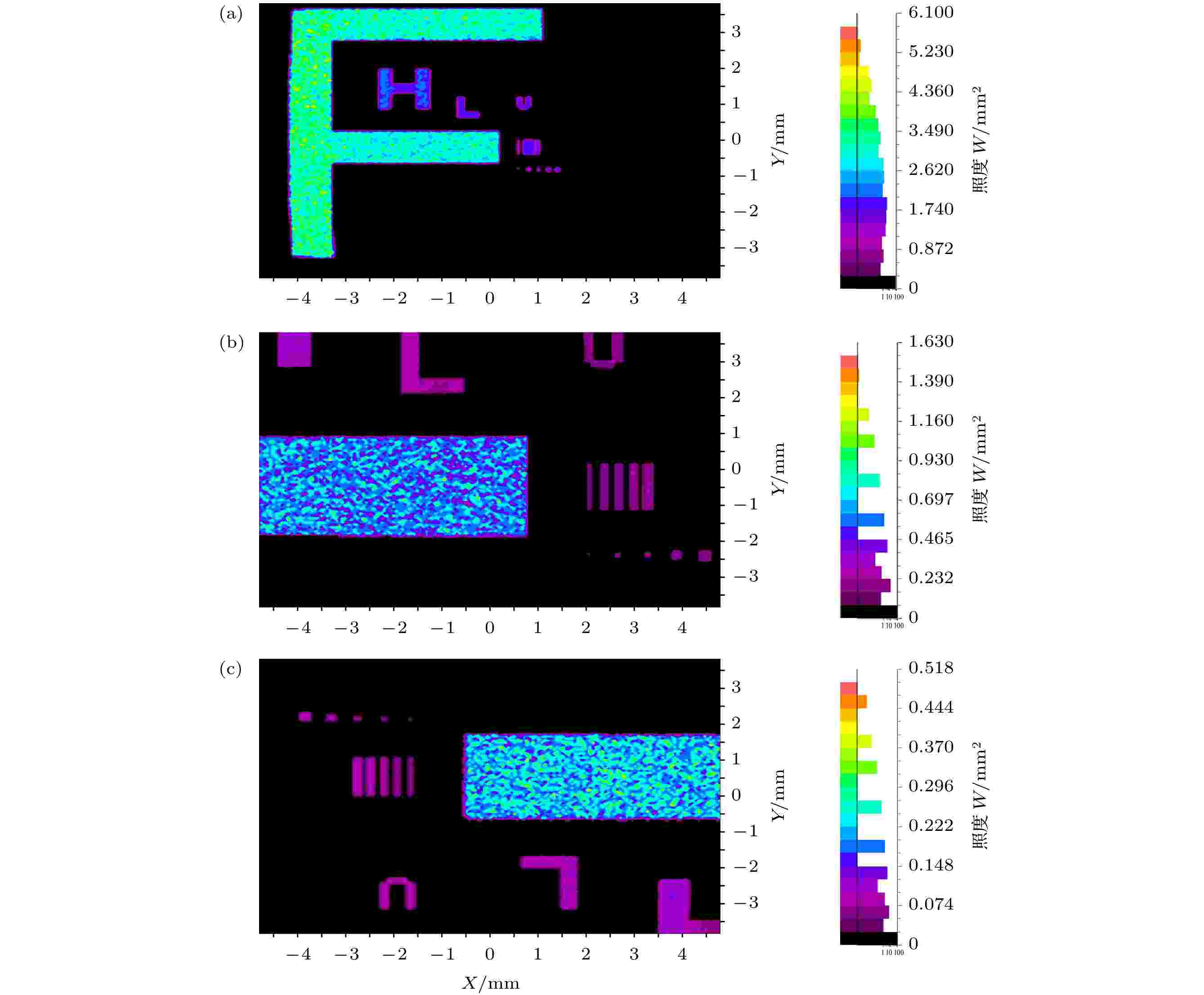 图 9 成像照度分析图 (a)短波红外短焦模式; (b)短波红外长焦模式; (c)偏振成像激光雷达
图 9 成像照度分析图 (a)短波红外短焦模式; (b)短波红外长焦模式; (c)偏振成像激光雷达Figure9. Analysis diagram of the imaging illuminance: (a) Short-wave infrared short-focus mode; (b) short-wave infrared long-focus mode; (c) polarization imaging lidar.
将偏振成像激光雷达与短波红外长焦模式成像结果比较, 如图10所示, 偏振成像激光雷达接收照度值约为短波红外长焦模式下的2.4倍, 且偏振成像激光雷达整体能量分布更加均衡.
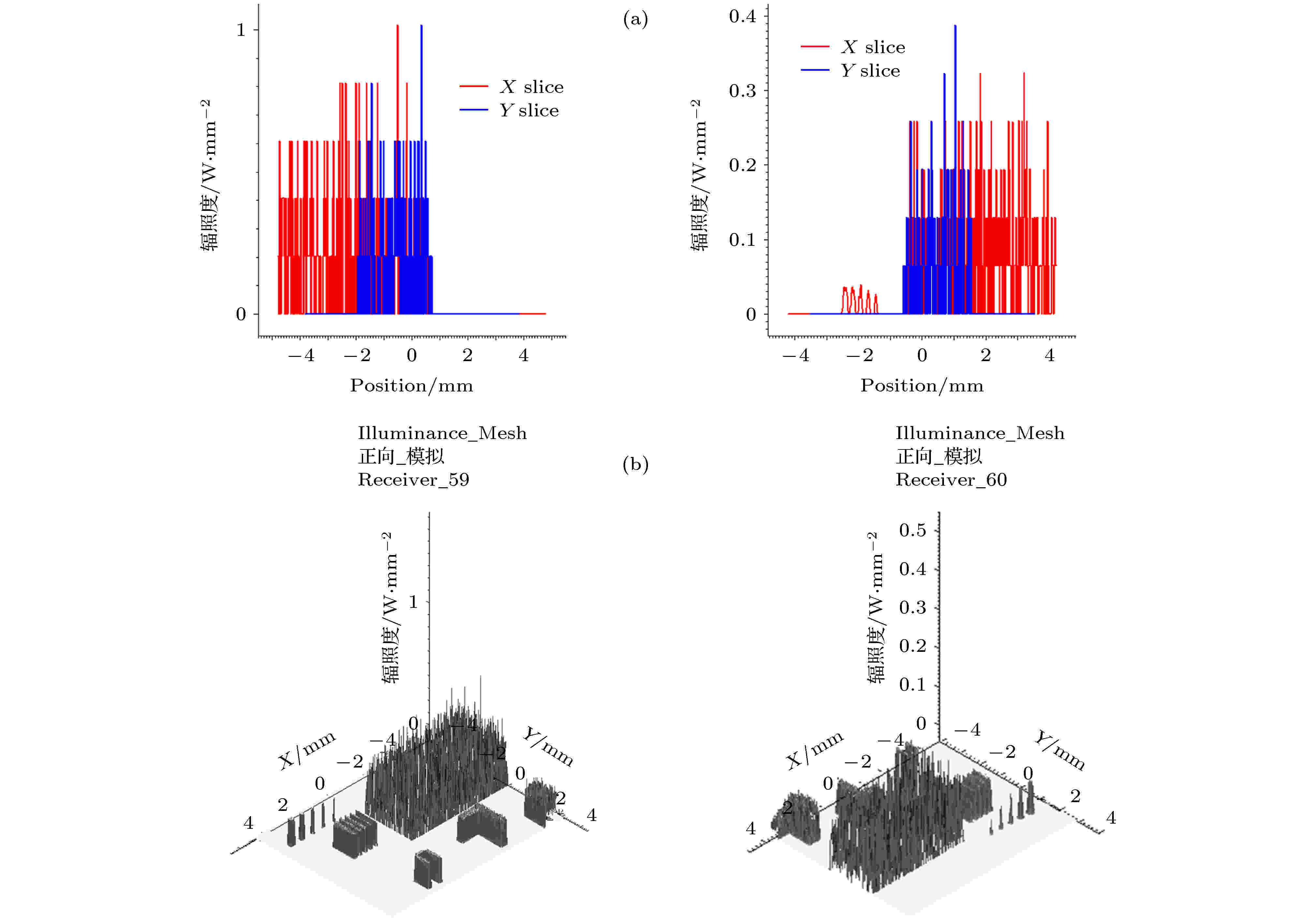 图 10 偏振成像激光雷达与短波红外长焦模式照度对比图 (a)成像表面照度; (b)三维照度对比图
图 10 偏振成像激光雷达与短波红外长焦模式照度对比图 (a)成像表面照度; (b)三维照度对比图Figure10. Contrast chart of the polarization imaging liDAR and short-wave infrared long-focus mode imaging: (a) Surface illumination; (b) three-dimensional illumination.
